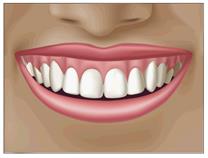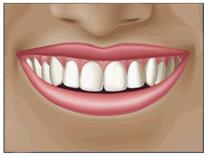Correct Gummy Smile
What is a "gummy smile"?
A "gummy smile" occurs when gum tissue is very thick and covers a large amount of tooth surface on your upper teeth. This makes teeth appear very short, even though they may be the proper length.
The amount of teeth/gums showing when a person smiles is due to a number of reasons, including:
- The shape/size of your lips
- Your facial muscles
- The shape/size of your teeth
- Your gum tissue
The ideal smile line should reveal the least amount of gum tissue possible. The gum tissue visible when smiling, should have balanced, even contours that match the upper lip. For these reasons, some people with a "gummy smile" feel their smile is unattractive and are reluctant to smile at all.
What causes a "gummy smile"?
There are several possible reasons a person may have a "gummy smile":
- An abnormality when adult teeth break through the gum surface to replace baby teeth
- Hypermobile upper lip muscle which raises the upper lip too high when smiling
- Short upper lip
- The way in which your upper jaw bone grew and developed
- The teeth don't make their way fully out of the bone
- Gum tissue doesn't recede as a person matures
- Excessive overbite
- Side effect from taking certain prescription medications
- Genetics
Affect on oral health
Sometimes people with a "gummy smile" may seek treatment for esthetic reasons. However, depending on the cause, it can be a sign of a more serious dental condition.
For instance, if your "gummy smile" is caused by an abnormality in jaw bone formation or when adult teeth broke through the gum surface, you may also have an improper bite. This may not only be uncomfortable, but it can also have a long-term negative affect on your oral health.
An option for those with a "gummy smile"
The following procedures are generally performed by periodontists and can be used to reshape excess gums, exposing more of the natural tooth in order to fix a “gummy smile”. They can improve symmetry of your teeth and produce a more attractive smile.
Gingivectomy means removing the gingiva (gums). It is used to remove gum tissue that has grown too much.
Gingivoplasty is used to reshape healthy gums.
Some dentists and periodontists may also recommend cosmetic crown lengthening. When referring to correcting a "gummy smile", this treatment is essentially the same as gingivectomy/gingivoplasty treatments, except that bone may also be reshaped during cosmetic crown lengthening to correct a "gummy smile". If needed, teeth may also be further restored (see crown lengthening).


Before After
Other alternative options
Some other alternatives for correcting a "gummy smile" include:
- Laser/botox treatments for minor cases
- Repositioning/lengthening the upper lip through surgery
- Orthodontic treatment (braces)
- Jaw bone maxillofacial surgery
Removing unhealthy gum tissue
Unhealthy gum tissue may be present whether a person has a "gummy smile" or not. Unhealthy gum tissue can produce pockets around teeth. When you have large pockets around teeth, it is hard to keep the area clean from food and bacteria. Gingivectomy alone can also be used to remove this unhealthy gum tissue which can trap bacteria and calculus deposits.
Gingivectomy can also be used to remove excess gum tissue growth formed as a result of taking certain prescription medication. By using these procedures, the periodontist can remove excess gum tissue and make teeth look more natural.











